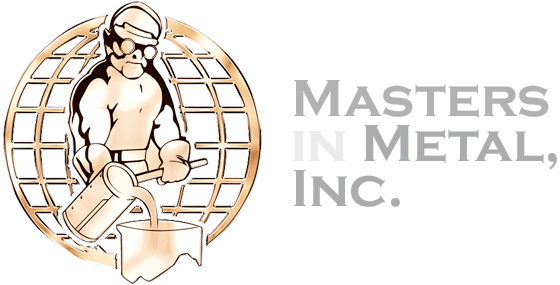 1
1The Original Sculpture
Our Staff Engineers will study the sculpture. A determination is made on how the sculpture will be sectioned or “laid up” for mold making. Complex molds will require the original artwork to be cut into smaller manageable pieces. This is by far the most critical step of the procedure. The detail of the original must be captured and transferred in the mold, if not, they will be difficult to replace in any other step.
 2
2Mold
After a sculpture arrives at Masters in Metal, the piece is carefully evaluated for molding. We must first decide how to divide the sculpture in order to create a mold to pour a wax. Once it has been decided how to divide the piece a day parting line is created. Several coats of rubber are then laid up on the sculpture followed by a plaster or fiberglass “mother mold”. This “mother mold” supports and gives body to the rubber while pouring a wax. The sculpture is then flipped over on the other side, the clay parting line removed, and more rubber is laid up on the opposite side followed by the other half of the “mother mold”.
 3
3Wax
Once a mold has been made, it is cleaned, and then a wax is poured and slushed into the cavity. The wax is built up to approximately 3/16 of an inch, allowed to cool, and then removed from the mold. After removing it from the mold, any parting lines and or tiny air bubbles are removed from the wax. Great care is taken so the wax is not changed from the original sculpture. Wax gates or sprues are then attached to the wax sculpture creating a “tree”. The designing of the gating is one of the most critical stages to ensure a good casting. These gates are engineered to evacuate the wax from the ceramic shell that will be put on the sculpture at the next phase of casting and to allow the metal to flow into the cavity to capture every detail.
 4
4Shell
The wax tree is dipped into a solution of water and zircon flower, and then covered in a fine zircon sand. This process is repeated 5-7 times depending on the size of the casting. This repeated dipping of the wax “tree” gradually builds up layers of sand until a final shell is created. The shell is then loaded into an Autodave where pressurized steam is used to melt the wax from the shell. The final result is a perfect negative of the sculpture ready to receive molten metal.
 5
5Metal
The empty shell is inspected, then loaded into an oven and taken up to 1400 degrees Fahrenheit. At least two hours of burnout the shell is cured, pre-heated and ready to receive the molten bronze. The bronze is heated up to about 2000 degrees Fahrenheit and poured into the hollow shell. The metal is then allowed to cool and the shell material is carefully removed from the bronze.
 6
6Chase
Once the bronze has cooled and the shell removed, the gates are cut off and ground flush to the sculpture, followed by a preliminary sandblasting to remove any remaining shell material. The sculpture is then welded back together, assembled, and then prepared for patina. Various surface finishes are used depending on the type of patina being requested.
 7
7Patina
The chased bronze is then colored using various acids, heat, and chemicals. Hundreds of colors, designs, and patterns are possible. Let your imagination be your guide. Any polishing or satin finish work is done at this time. Finally, the sculpture is sealed and mounted if needed using a paste wax, lacquer, or hi-gloss enamel.
